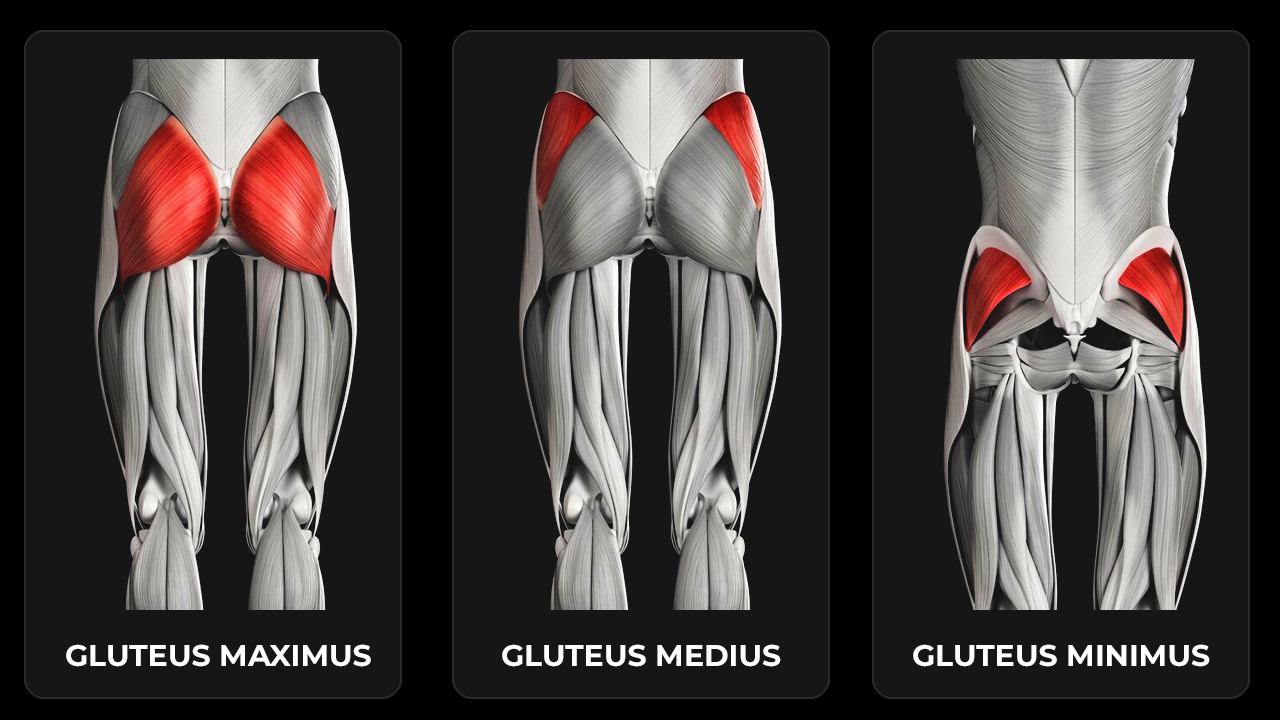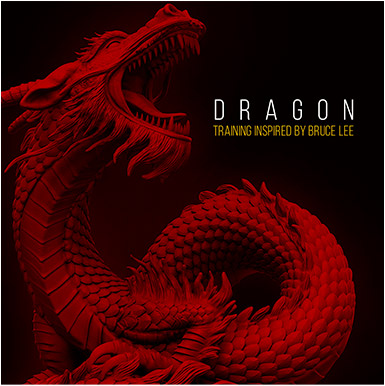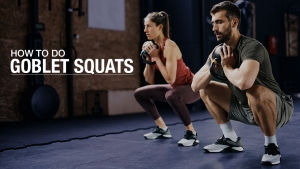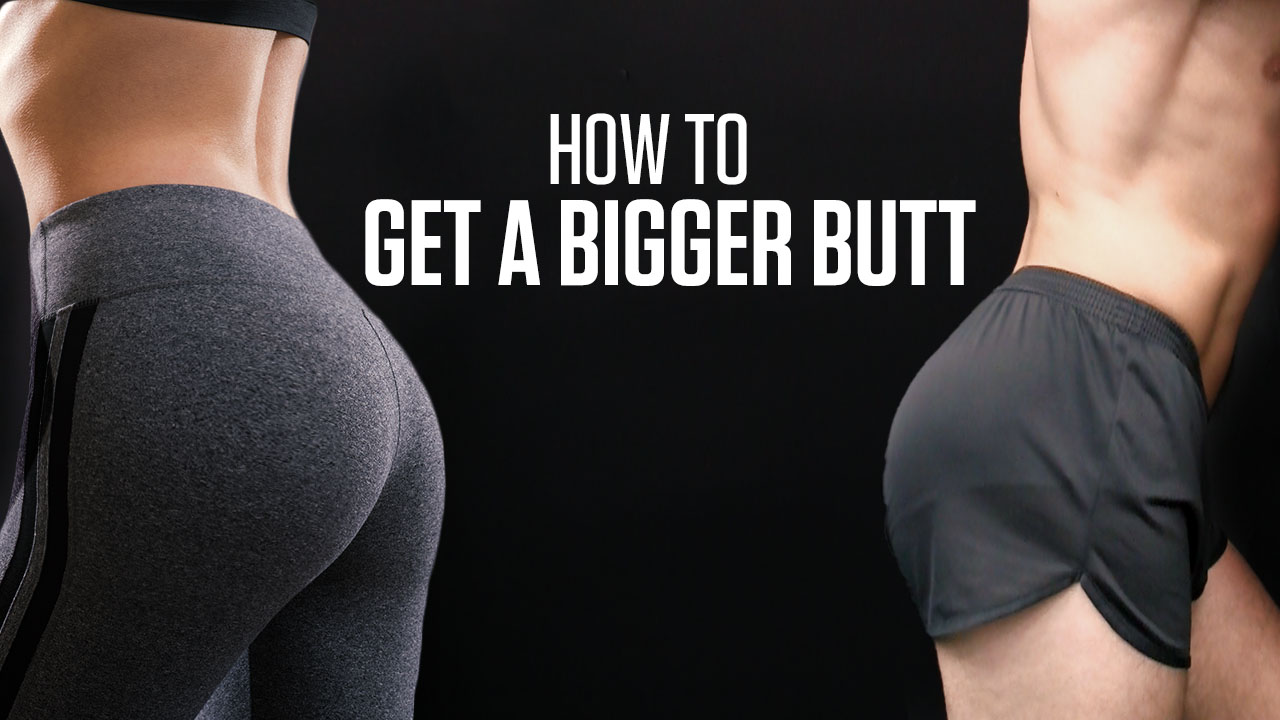
HOW TO GET A BIGGER BUTT
If all your pants are baggy pants because you’re lacking the butt required to hold them up, it’s time to grow your glutes.
But let’s clear something up first:
Building a stronger, more prominent butt isn’t just about aesthetics.
It’s about improving overall strength, enhancing athletic performance, and even preventing injuries.
Your gluteal muscles are some of the most powerful in your body and they play a fundamental role in your mobility.
It’s time to embrace the strength, functionality, and yes, even the aesthetic appeal of a well-built butt.
Let’s take a closer look at the glute muscles, how to know if you’re activating them correctly, and the best exercises to grow your butt.
ANATOMY OF THE GLUTE MUSCLES
Before I discuss how to get a bigger butt, I want to start with breaking down the muscles you’ll be targeting.
After all, if you want to form the strongest mind-to-muscle connection you can, you need to learn about the muscle itself – not just the exercises.
What most people think of when they hear the word “glutes” comprises three sections or groups of muscle fibers.
GLUTEUS MAXIMUS
The gluteus maximus is the muscle that almost everyone points to when they think of butt muscles. And they aren’t wrong.
The gluteus maximus, the biggest among the trio of gluteal muscles, significantly contributes to the contour of your buttocks.
But it does so much more than that.
It’s not only significant for its aesthetic contribution but also for its functional importance in various movements and activities.
The gluteus maximus begins from the upper part of your hip bone, as well as the lower end of your spine. This includes the sacrum and the coccyx (that’s the very bottom part of your spine, often called the tailbone). It also attaches to a strong ligament in that area.
From there, the muscle stretches down and attaches to two main points on your thigh: the iliotibial tract, which is a thick band running down the outside of your thigh, and a specific spot on the back of your thigh bone.
The gluteus maximus serves several functions in the body:
- Hip Extension: It is the primary muscle responsible for extending the hip, which is involved in movements like standing up from a seated position, climbing stairs, and running.
- Lateral Rotation of the Hip: The muscle also helps in rotating the thigh outward, which is necessary for stabilizing the hip joint during various movements.
- Upper Thigh Abduction: When the hip is flexed, the gluteus maximus aids in moving the thigh away from the body’s midline.
- Postural Support: It plays a significant role in maintaining an upright posture. The strength and tone of the gluteus maximus are crucial for lower back health and overall body alignment.
- Stabilizing the Sacroiliac Joint: This joint is where the spine meets the pelvis. The gluteus maximus helps in stabilizing this area, particularly during movements that involve the lower body.
GLUTEUS MEDIUS
The gluteus medius is lesser known compared to the gluteus maximus but plays an equally important role in movement.
The gluteus medius muscle starts from the external surface of the ilium, which is the wide, wing-shaped section of the pelvic bone. The muscle specifically begins in the area between the front and back gluteal lines. This is an area on the lateral aspect of the pelvis, just below the iliac crest (the top, curved part of the hip bone).
The fibers of the gluteus medius converge to insert on the lateral (outside) surface of the greater trochanter of the femur. The greater trochanter is a prominent, bony protrusion on the upper part of the thigh bone (femur) and serves as an attachment point for several muscles.
The gluteus medius serves multiple functions:
- Abduction of the Hip: Its primary function is to abduct the hip, meaning it moves the thigh away from the body’s midline. This movement is involved in activities like walking, running, and balancing on one leg.
- Medial and Lateral Rotation of the Hip: Depending on the position of the hip and thigh, the gluteus medius can also assist in rotating the thigh inward (medial rotation) or outward (lateral rotation).
- Pelvic Stability: The gluteus medius stabilizes the pelvis, especially when standing on one leg. This is important for maintaining balance and a proper gait.
- Posture Maintenance: By stabilizing the pelvis, the gluteus medius also contributes to maintaining overall posture.
GLUTEUS MINIMUS
The glute minimus is the smallest of the three major gluteal muscles, yet it plays a vital role in hip function and stability. Despite its size, it’s fundamental for various movements and maintaining balance as well as overall glute muscle growth.
The gluteus minimus muscle begins from the external surface of the ilium, a section of the pelvic bone. Specifically, it emerges from the region between the front and lower gluteal lines. This location is on the lower portion of the hip bone, beneath the gluteus medius.
The muscle extends downwards to insert into the anterior (front) part of the greater trochanter of the femur. The greater trochanter is a bony prominence on the upper thigh bone, serving as an attachment point for muscles.
The gluteus minimus has several important functions:
- Abduction of the Hip: Similar to the gluteus medius, one of its primary functions is to abduct the hip. This action is essential for side-to-side movements and contributes to balance during walking and running.
- Medial Rotation of the Hip: When the hip is flexed (as in when you’re sitting or bending your hip), the gluteus minimus helps in the medial rotation of the thigh, turning it inward.
- Pelvic Stability: It also plays a key role in stabilizing the pelvis, especially when you are standing on one leg.
- Posture Support: By aiding in pelvic stability, the gluteus minimus also supports overall body posture, particularly during movement.
WHY IS IT IMPORTANT TO TRAIN YOUR GLUTES?
In popular fitness media, training the glute muscles is often associated with aesthetic goals.
But this is only one part of a much bigger picture.
Sure, it’s nice to have a killer booty, but glute building movements go beyond the visual appeal. They contribute significantly to overall health, athletic performance, and injury prevention.
FUNCTIONAL MOVEMENT PATTERNS
The glutes are among the largest and most powerful muscle groups in the human body, playing a pivotal role in a wide range of movements.
These muscles are essential for basic functional movements such as standing, walking, climbing stairs, and lifting objects.
ATHLETIC PERFORMANCE
In the realm of athletic performance, well-trained glutes are a requirement. These muscles are important for explosive movements, agility, and speed, making them vital for virtually every type of athlete.
From sprinters and cyclists to football players and weightlifters, powerful glutes contribute to improved performance.
They help in generating force and power during activities like running, jumping, and changing direction quickly.
This enhancement in athletic abilities is not just beneficial for competitive athletes but also for anyone engaged in recreational sports or physical activities.
PROPER POSTURE
Strong glute muscles maintain proper posture and alignment.
Weak or underactive glutes can lead to a chain reaction of muscle imbalances and misalignments, often resulting in lower back pain, one of the most common physical complaints.
The glutes work in conjunction with the lower back and hamstrings to support the pelvis and spine. When the glutes are weak, other muscles have to compensate, leading to strain and discomfort in the lower back, hips, and even knees.
Strengthening the glutes can alleviate and prevent lower back pain by ensuring that the pelvis and spine are adequately supported.
INJURY PREVENTION
The glutes play a significant role in stabilizing the hips and knees, joints that are particularly vulnerable to injuries, especially in sports and physical activities.
Strong glutes can help in preventing common injuries such as ACL tears, hip impingement, and patellofemoral pain syndrome.
By ensuring proper alignment and movement patterns, well-conditioned glutes can reduce the risk of these and other injuries.
SUPPORTS OTHER MOVEMENTS
Another aspect often overlooked is the role of strong glutes in enhancing other areas of training.
For instance, in weightlifting, powerful glutes contribute significantly to lifts such as Jump Squats, Deadlifts, and Olympic lifts.
They provide the stability and power necessary to perform these movements effectively and safely. Thus, glute training can be a cornerstone for overall strength and conditioning.
GLUTE ACTIVATION TEST
Guys, remember that it’s not about the movement, it’s about the activation of the muscle during the movement.
You can perform the best glute exercises, but if you don’t know how to activate the muscle, you’ll leave gains on the floor.
Before I reveal the exercise for glute growth, I want you to take a quick glute activation test.


On the floor, position yourself on all fours, then extend one leg fully behind you and lift it up towards the ceiling.
What you should be feeling is a strong, intense range of motion and contraction in the glute max muscle, similar to the feeling you get when you flex your bicep tightly.
If you’re not experiencing this sensation, it’s a sign you should continue reading.
If you think that you feel it, great, but there’s a chance you might not have done the test with the correct form.
Many people mistakenly turn their leg slightly outward, which engages the gluteus medius or minimus instead. This test is specifically for the gluteus maximus, so focus only on activating that muscle.
Try the test again. This time, make sure to check the position of your toes – they should point straight down, not to the side.
With your toes pointed down, were you able to feel the activation in the entire glute maximus?
If not, that’s okay! You’re certainly not alone and I’m going to tell you how to fix this issue.
Why does proper activation really matter anyway?
Poor control over the glute max can undermine your efforts in exercises like squats and deadlifts, turning them into back-dominant instead of glute-dominant movements.
This not only decreases the effectiveness of these exercises but also increases your risk of lower back pain, especially when lifting heavy weights.
So, what’s the solution?
I’ve got two exercises for you to start doing to ensure you’re activating the glute muscles properly.
GLUTE ACTIVATION EXERCISES
If you’re having trouble fully contracting your glutes, I want you to start here. Don’t worry about any other glute exercises for filling out a pair of pants yet.
As your trainer, my goal is to help you address any muscle imbalances in your glutes. Correcting these will help you do more than grow your butt.
You’ll see better performance in exercises like squats and lunges. You’ll see yourself getting stronger, especially unilateral strength. Most importantly, you’ll reduce your risk of injury.
I’ll introduce you to two effective glute activation exercises that target those booty fibers and don’t require gym machines.
For the first exercise, you just need a pull-up bar and a pair of resistance bands. For the second exercise aimed at glute growth, all you need is a wall.
Remember, we’re not replacing your compound lifts or lower body routine; we’re enhancing them. These glute activation exercises should be integrated into your normal leg day or glute workouts.
RESISTANCE BAND KICKBACK

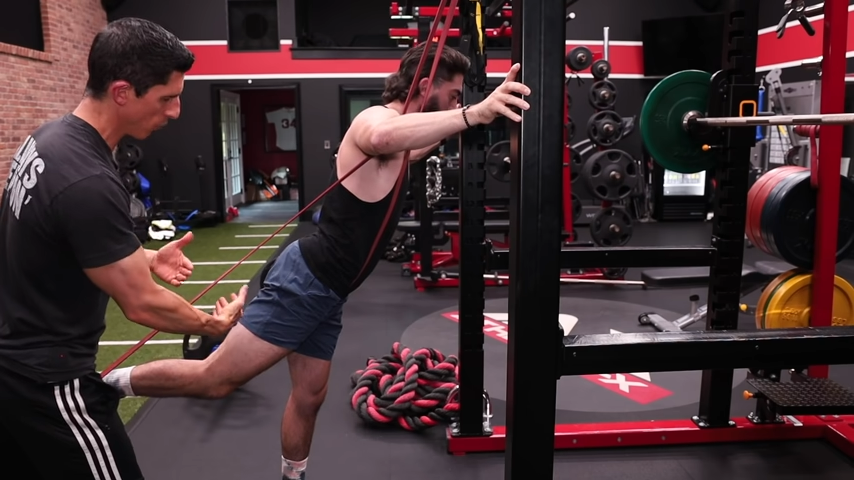
HOW TO DO THE RESISTANCE BAND KICKBACK:
- Also known as Booty Kicks, wrap a resistance band around a pull-up bar and place one foot inside the loop of the band.
- Stand straight, allowing your hip to rise as high as possible. This position initiates hip flexion and engages the glutes.
- Apply pressure downwards against the band by stretching your leg backward, making sure your toes point downwards to focus on hip extension.
- Push your leg against the band with maximum effort. Lift your leg against gravity’s pull to intensify glute muscle activation.
- Begin the exercise with your hip at about 110 degrees of flexion. Extend your hip to approximately 130 degrees for full range and maximum glute engagement.
- Take a 30-second rest then move to the next exercise.
WHAT MAKES IT EFFECTIVE: Maintaining tension on the glute max throughout the movement, especially at full extension, ensures you’re activating the target muscle. Also, be sure to avoid rotation, keeping the toes pointed downwards throughout the exercise to properly target the glute max.
WALL SINGLE-LEG GLUTE BRIDGE

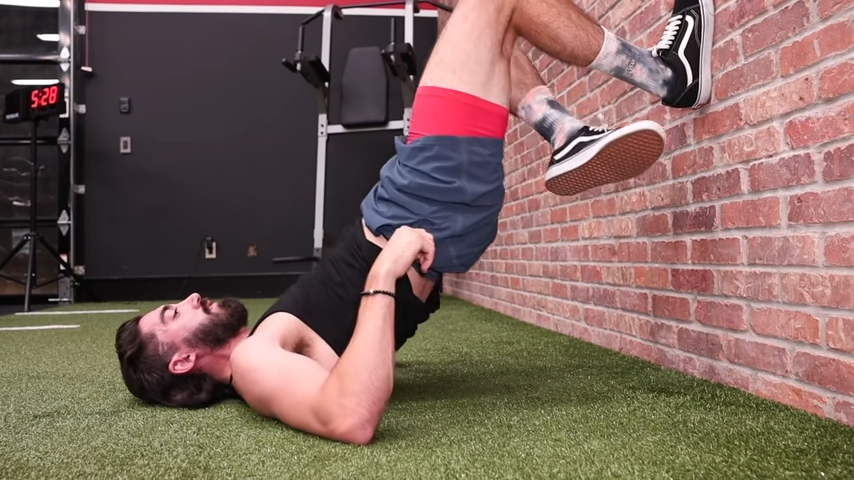
HOW TO DO THE WALL SINGLE-LEG GLUTE BRIDGE:
- Lie down on your back on the floor, facing upwards. Bend your knees and place your feet flat against a wall.
- Choose the leg you will not be working with. Fold it downwards and under, aiming to bring your shin as close to the wall as possible. This increases hip flexion on that side.
- Pay attention to how you push through the foot of your working leg. Avoid lifting your toes off the wall or pushing solely through the heel, as this can over-activate the hamstrings, which isn’t the goal.
- Keep your foot flat against the wall. Aim to push through the entire sole of your foot for a balanced effort.
- Slowly lift your hips into a bridge position. Focus on driving the movement through the glute max of your working leg.
- Ascend until your hips are fully extended, while keeping the top half of your upper body on the ground.
- Hold the bridge position for a second or two at the top. Slowly lower your hips back to the starting position and prepare for the next repetition.
WHAT MAKES IT EFFECTIVE: These butt lifts or butt bridges are effective because you’re focusing on one side at a time in order to help you engage and contract the muscle.
BEST EXERCISES TO GROW YOUR BUTT
Let’s say you passed the glute activation test with flying colors – What exercises should you be focusing on to grow your butt?
First, I’ll say that even if you were able to feel glute activation during the test, I’d still recommend incorporating those glute activation exercises into your normal routine.
Why?
Proper activation isn’t something that you want to lose. And like any other muscle, you need to train it well and train it often to maintain that level of activation.
Even if you only do one set of each glute activation exercise, that’s going to help your body remember how to do it with proper form.
Glute activation aside, when you’re putting together a workout, you’ll want to focus on the most effective exercises for the glutes. That means selecting exercises that target all three sections of the muscle.
Unfortunately, there is no single golden butt exercise, but there are several that stand out as being the most effective.
Along with these exercises, you want to use the proper acute variables.
For movements that use heavy weight, aim for 8-12 reps. Exercises that use body weight should be higher in rep range.
Shoot for 2-3 glute workouts per week, incorporating the butt exercises into your leg day workouts. The glute-focused exercise portion of your workouts shouldn’t take any more than 20-30 minutes.
Above all, make sure you have a balanced week of workouts. Don’t focus solely on lower body and glute workouts.
Here are my favorite moves for glute hypertrophy, starting with the classic Barbell Hip Thrust.
BARBELL HIP THRUST


HOW TO DO THE BARBELL HIP THRUST:
- Place a bench horizontally or a stable elevated surface behind you. Have a barbell with the appropriate weight in front of the bench.
- Sit on the ground with your upper back against the bench. Your feet should be flat on the floor, and your legs should form 90-degree angles when bent.
- Roll the barbell over your legs so that it sits just above your hips. You may use a padded barbell cover or a mat for comfort.
- Lean back so that your shoulder blades are resting on the bench.
- Drive through your heels to lift your hips up, pushing the barbell upwards. At the top of the movement, your body should create a straight line from your shoulders to your knees.
- At the top of the lift, pause for a second and squeeze your glutes. Keep the core tensed.
- Slowly lower your hips back down to the starting position, controlling the movement.
WHAT MAKES IT EFFECTIVE: The Barbell Hip Thrust requires you to fully contract your glutes in order to move the weight up. It’s also one of the few glute-focused exercises that allows you to go heavy. If you’re new to the Barbell Hip Thrust, I’d recommend starting with Glute Bridges first to develop the proper movement pattern.
BARBELL ROMANIAN DEADLIFT (RDL)

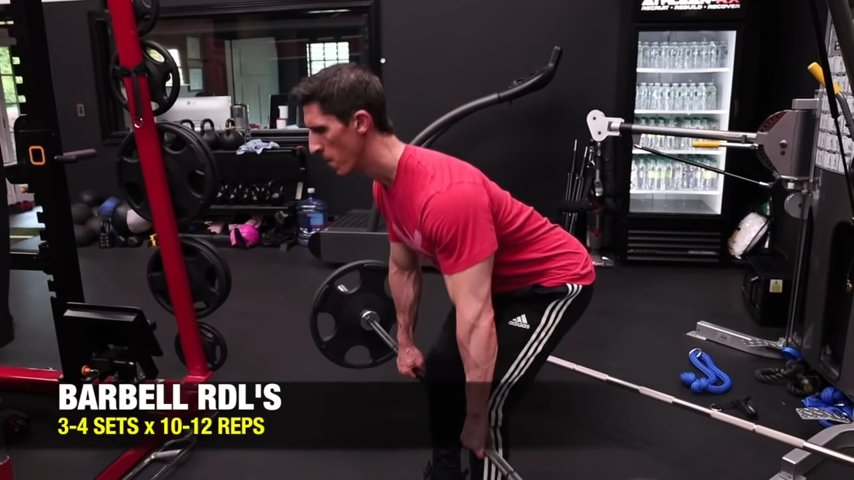
HOW TO DO THE BARBELL ROMANIAN DEADLIFT:
- Place a barbell in front of you on the ground. Choose a weight that is challenging but allows you to maintain good form throughout the exercise.
- Position yourself with your feet spaced hip-width apart, directly facing the barbell. Your toes should either point straight ahead or angle slightly outward.
- Flex at your hips and knees, then grasp the barbell with both hands. Position your hands slightly wider than your legs, utilizing an overhand grip.
- Straighten your legs slightly to lift the barbell off the ground, but keep your knees slightly bent throughout the exercise. This is your starting position.
- Maintain a straight back and an active core, then lean forward from your hips while pushing your hips backward. Let the barbell descend along the front of your legs.
- Continue to lower the barbell while maintaining a flat back, until you feel a stretch in your hamstrings. Your flexibility will determine how low you can go.
- Engage your hamstrings and glutes to reverse the motion, bringing your torso back up to the standing position. Keep the barbell close to your body throughout the movement.
WHAT MAKES IT EFFECTIVE: Just like Barbell Hip Thrusts, Barbell Deadlifts require you to fully contract the glute muscles to return to the starting position. This is also a great exercise to go heavy on, especially if you want to build stronger glutes. If you want to challenge your stability and mobility, consider performing Single-Leg Deadlifts with ankle weights. If you’re looking for an alternative due to hip mobility, Sumo Deadlifts might be a good choice.
DUMBBELL SPRINTER LUNGE


HOW TO DO THE DUMBBELL SPRINTER LUNGE:
- Choose dumbbells that challenge you but still allow for proper form, aligning with the principle of progressive overload for muscle growth.
- Begin in a split squat stance, holding a dumbbell in each hand by your sides. Stand with one foot forward and the other extended back, ensuring you’re in a balanced lunge position.
- Engage your core for stability throughout the exercise. This helps maintain balance and supports overall health and fitness.
- Lower your body by bending your knees, keeping a slight bend in the rear knee. Ensure your front knee is aligned with your front ankle and does not extend past your toes.
- From the bottom of the lunge, drive through the heel of your front foot to propel your body upward. The planes of motion should be powerful and controlled, simulating a sprinter’s action.
- As you rise, switch your leg position, landing with the opposite leg forward in a lunge position. This dynamic movement helps improve core stability and enhances the exercise’s effectiveness.
- Continue the lunging motion, alternating legs.
WHAT MAKES IT EFFECTIVE: Think of these like Reverse Walking Lunges with alternating feet behind body. The key is to drive your body back up to the top and quickly get the other leg in place so you can perform this in alternating fashion. If you really want to add another level of intensity to the exercise, consider using a weighted vest.
CABLE PULL THROUGH


HOW TO DO THE CABLE PULL THROUGH:
- Position a cable machine with a rope attachment at the lowest setting. Select a weight that is challenging but allows you to maintain proper form, aiding in muscle mass development.
- Stand facing away from the cable machine, with your feet placed flat on the floor, slightly wider than hip-width apart. This stance will activate the largest muscle groups in the lower body.
- Bend down and grasp the rope attachment between your legs, using both hands. Your arms should be straight, and your palms should face each other.
- Ensure your spine is in a neutral position, and your knees are slightly bent. Your knees should be in line with your hips, promoting knee tracking and stability.
- With your core engaged, hinge forward at your hips, allowing the cable to pull your arms and torso toward floor. This movement should be controlled and focused on the trio of glutes.
- Engage your glutes and hamstrings to pull the cable back to the starting position. Keep your feet flat and push through your heels for effective glute building movements.
- At the top of the movement, fully extend your hips forward, squeezing your glutes. Be careful not to overextend your lower back.
- Return to the lengthened position by hinging at the hips again, maintaining tension on the cable throughout the motion. This repetition helps in building muscle mass in the glutes and hamstrings.
WHAT MAKES IT EFFECTIVE: The primary effectiveness of the Cable Pull Through for the glutes lies in its focus on full hip extension, which intensely activates and strengthens the glute muscles.
BANDED HIP DROP

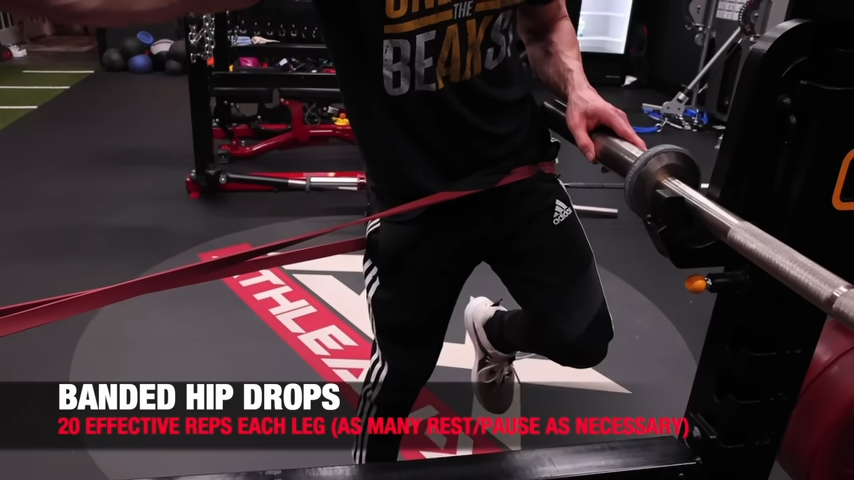
HOW TO DO THE BANDED HIP DROP:
- Simply anchor the resistance band around something stable like a cable machine and put the band around thighs or hips, depending on your height. A mini resistance band won’t work here – you’ll need a full-sized one.
- Hold on to something for support and allow your hips to drop in the direction that the band is anchored.
- Doing that just sets you up to perform this right. What I want you to do is now drive your hips back in the opposite direction against the resistance of the band.
- Perform the suggested repetitions for the exercise and then switch sides.
WHAT MAKES IT EFFECTIVE: By performing this exercise right, you’re getting abduction of the hip on that down leg. That means you’re actually heavily targeting your glute medius, which is oftentimes a very weak (and overlooked) muscle.
GLUTE BRIDGE CURL

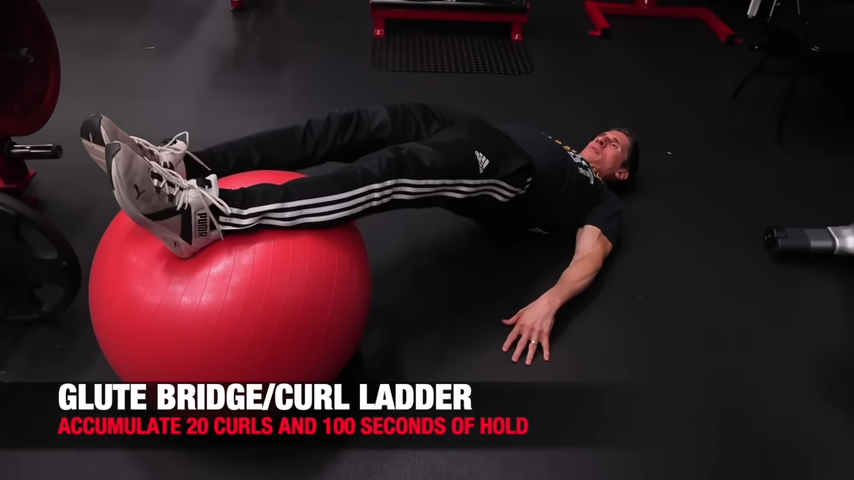
HOW TO DO THE GLUTE BRIDGE CURL:
- Place a Swiss Ball near you and lie down on your back on a mat, with your legs extended, feet resting on the ball, and knees hip width. Keep your hands touching floor.
- Bend your knees to roll the ball towards your body until your feet are flat on the ball. Your legs should be hip-width apart.
- Engage your core and glutes to lift your hips until body forms a straight line from your shoulders to your knees.
- Keeping your hips raised, slowly roll the ball away from you by straightening your legs. Keep your feet flat on the ball and be careful with your ankle movement.
- Pull the ball back towards you by bending your knees, returning to the initial bridge position while keeping your hips elevated.
- Throughout the exercise, focus on keeping your hips stable and aligned with your knees and shoulders.
WHAT MAKES IT EFFECTIVE: The most important reason the Glute Bridge Curl is effective for targeting the glutes is the enhanced muscle activation required to maintain balance and control throughout the exercise. This activation is especially pronounced due to the instability of the Swiss Ball, which engages the glute muscles more intensively compared to performing the movement on a stable surface.
When you want to grow your butt fast, it’s important to remember that “fast” is a relative term in fitness.
Quick-fix methods, especially those promising extremely rapid results, should be approached with caution.
Significant changes in muscle size – including your booty – take time and dedication. Not to mention the right workout program.
If you want a complete workout for your whole body that boosts muscle and strength, check out our ATHLEAN-X programs. We’ve got something just right for everyone, no matter what you’re aiming for or the tools you have.

- Improving overall strength, enhancing athletic performance, and preventing injuries are key benefits of building a stronger, more prominent butt, beyond just aesthetics.
- Proper activation of glute muscles during exercises is essential for their effectiveness.
- A simple glute activation test can help determine correct engagement of the gluteus maximus:
- When you position yourself on all fours on the floor, extend one leg fully behind you and lift it towards the ceiling, you should feel a strong, intense contraction in the glute max muscle.
- Resistance Bands Kickbacks and Wall Single-Leg Glute Bridges can improve glute activation, enhance overall performance, and protect your body from injury.
- Targeting all sections of the glute muscle is crucial. To do this, you can use a variety of exercises for building glutes including Barbell Hip Thrusts, Romanian Deadlift, Sprinter Lunges, and Cable Pull Throughs.
- Noticeable glute size changes typically occur within 6 to 12 weeks of consistent, targeted strength training.
HOW TO GET A BIGGER BUTT FAQ
The time it takes to get a bigger butt through exercise varies greatly depending on several factors, including your starting point, genetics, workout intensity, frequency, balanced diet, and overall lifestyle.
Typically, noticeable changes in muscle size, such as glute growth, can be seen within 6 to 12 weeks of consistent, targeted strength training, provided you're following a well-structured workout plan and nutrition strategy.
However, it's important to remember that individual results may vary. Some people might see changes sooner, while for others, it might take longer. Genetics play a significant role in determining where and how quickly your body builds muscle.
Consistency and progressively challenging workouts are key factors in muscle development and getting a toned butt. Additionally, adequate lean protein intake, proper rest, and overall caloric balance are necessary to support muscle growth and recovery.
Squats can definitely help in making your butt bigger as they effectively target the gluteal muscles, particularly the gluteus maximus.
For optimal results with your body composition, squats should be part of a well-rounded exercise routine that includes other glute-focused exercises like Hip Thrusts and Romanian Deadlifts.
Progressive overload, such as increasing weight or using different glute-focused exercises, is a requirement for muscle growth.
Nutrition and recovery play an important role in muscle development, and individual genetics also influence muscle gain. Consistency in your workout routine is key to achieving and maintaining a bigger butt.
To grow two inches in your glutes body development, a focused approach combining targeted strength training, proper nutrition, and adequate rest is essential.
Incorporate exercises such as Hip Thrusts, Romanian Deadlifts, Banded Hip Drops, and Cable Pull Throughs into your routine, at least 2-3 times a week.
Emphasize progressive overload by gradually increasing workout intensity, whether through added weight, more repetitions, or varied exercises.
Naturally, consistency in your training regimen is a must for sustained progress.
Alongside exercise, your diet should support muscle growth, with a balanced intake of protein such as lean beef and Greek yogurt, complex carbohydrates including brown rice, and healthy fats such as olive oil.
Rest and recovery are equally important, including getting enough sleep and scheduling rest days for muscle repair.
Regularly measure your glutes to track your progress and make adjustments to your program as needed.
Not everyone has amazing glute genetics so what can you do to get a bigger butt fast?
Achieving a bigger butt quickly involves a combination of targeted exercise, nutrition, and overall lifestyle adjustments.
Exercise: Focus on glute-strengthening exercises like Squats, Sprinter Lunges, Romanian Deadlifts, Hip Thrusts, and Glute Bridges. Work your glutes two days per week, ensuring each workout is challenging but safe. As far as your total workouts per week, make sure you’re incorporating glute exercises into your leg day routine.
Nutrition: Increase your protein intake to support muscle growth and repair. Aim for 20 to 30 grams of protein per meal. Ensure you're consuming a calorie surplus – eating more calories than you burn – to facilitate muscle gain. Include a balanced mix of carbohydrates, fats, and proteins in your healthy diet.
Recovery: Allow adequate time for rest and muscle recovery. Overworking your muscles can lead to injuries and setbacks.
Consistency and Patience: While you're looking for fast results, it's important to be patient and consistent. Rapid muscle growth is challenging and varies based on individual genetics and current fitness levels.
Supplementation: Consider supplements like protein powders or BCAAs, but only after chatting with your doctor.
Professional Guidance: Consider working with a personal trainer or physical therapist to ensure you're performing exercises correctly and effectively.
REFERENCES

Jeff Cavaliere M.S.P.T, CSCS
Jeff Cavaliere is a Physical Therapist, Strength Coach and creator of the ATHLEAN-X Training Programs and ATHLEAN-Rx Supplements. He has a Masters in Physical Therapy (MSPT) and has worked as Head Physical Therapist for the New York Mets, as well as training many elite professional athletes in Major League Baseball, NFL, MMA and professional wrestling. His programs produce “next level” achievements in muscle size, strength and performance for professional athletes and anyone looking to build a muscular athletic physique.
















